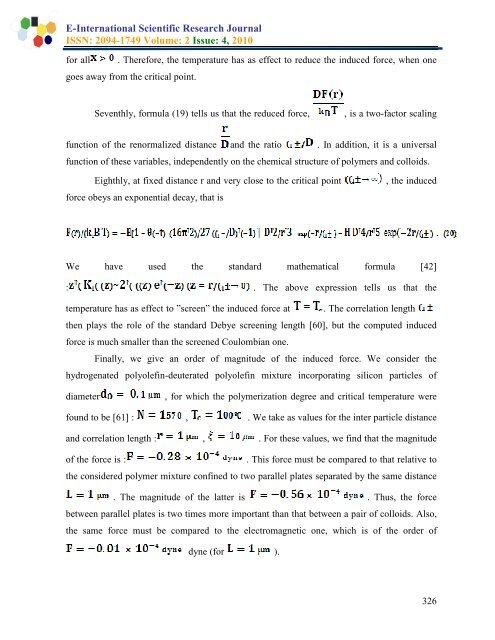download the full article here - EISRJC
download the full article here - EISRJC
download the full article here - EISRJC
You also want an ePaper? Increase the reach of your titles
YUMPU automatically turns print PDFs into web optimized ePapers that Google loves.
E-International Scientific Research JournalISSN: 2094-1749 Volume: 2 Issue: 4, 2010for all. T<strong>here</strong>fore, <strong>the</strong> temperature has as effect to reduce <strong>the</strong> induced force, when onegoes away from <strong>the</strong> critical point.Seventhly, formula (19) tells us that <strong>the</strong> reduced force,, is a two-factor scalingfunction of <strong>the</strong> renormalized distance and <strong>the</strong> ratio . In addition, it is a universalfunction of <strong>the</strong>se variables, independently on <strong>the</strong> chemical structure of polymers and colloids.Eighthly, at fixed distance r and very close to <strong>the</strong> critical pointforce obeys an exponential decay, that is, <strong>the</strong> inducedWe have used <strong>the</strong> standard ma<strong>the</strong>matical formula [42]: . The above expression tells us that <strong>the</strong>temperature has as effect to ”screen” <strong>the</strong> induced force at . The correlation length<strong>the</strong>n plays <strong>the</strong> role of <strong>the</strong> standard Debye screening length [60], but <strong>the</strong> computed inducedforce is much smaller than <strong>the</strong> screened Coulombian one.Finally, we give an order of magnitude of <strong>the</strong> induced force. We consider <strong>the</strong>hydrogenated polyolefin-deuterated polyolefin mixture incorporating silicon p<strong>article</strong>s ofdiameter, for which <strong>the</strong> polymerization degree and critical temperature werefound to be [61] : , . We take as values for <strong>the</strong> inter p<strong>article</strong> distanceand correlation length : , . For <strong>the</strong>se values, we find that <strong>the</strong> magnitudeof <strong>the</strong> force is :. This force must be compared to that relative to<strong>the</strong> considered polymer mixture confined to two parallel plates separated by <strong>the</strong> same distance. The magnitude of <strong>the</strong> latter is . Thus, <strong>the</strong> forcebetween parallel plates is two times more important than that between a pair of colloids. Also,<strong>the</strong> same force must be compared to <strong>the</strong> electromagnetic one, which is of <strong>the</strong> order ofdyne (for ).326
















